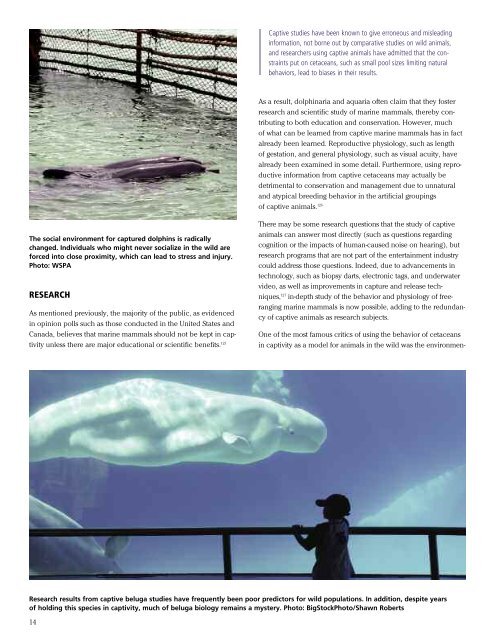The Case against Marine Mammals in Captivity - The Humane ...
The Case against Marine Mammals in Captivity - The Humane ...
The Case against Marine Mammals in Captivity - The Humane ...
- No tags were found...
You also want an ePaper? Increase the reach of your titles
YUMPU automatically turns print PDFs into web optimized ePapers that Google loves.
Captive studies have been known to give erroneous and mislead<strong>in</strong>g<strong>in</strong>formation, not borne out by comparative studies on wild animals,and researchers us<strong>in</strong>g captive animals have admitted that the constra<strong>in</strong>tsput on cetaceans, such as small pool sizes limit<strong>in</strong>g naturalbehaviors, lead to biases <strong>in</strong> their results.As a result, dolph<strong>in</strong>aria and aquaria often claim that they fosterresearch and scientific study of mar<strong>in</strong>e mammals, thereby contribut<strong>in</strong>gto both education and conservation. However, muchof what can be learned from captive mar<strong>in</strong>e mammals has <strong>in</strong> factalready been learned. Reproductive physiology, such as lengthof gestation, and general physiology, such as visual acuity, havealready been exam<strong>in</strong>ed <strong>in</strong> some detail. Furthermore, us<strong>in</strong>g reproductive<strong>in</strong>formation from captive cetaceans may actually bedetrimental to conservation and management due to unnaturaland atypical breed<strong>in</strong>g behavior <strong>in</strong> the artificial group<strong>in</strong>gsof captive animals. 126<strong>The</strong> social environment for captured dolph<strong>in</strong>s is radicallychanged. Individuals who might never socialize <strong>in</strong> the wild areforced <strong>in</strong>to close proximity, which can lead to stress and <strong>in</strong>jury.Photo: WSPARESEARCHAs mentioned previously, the majority of the public, as evidenced<strong>in</strong> op<strong>in</strong>ion polls such as those conducted <strong>in</strong> the United States andCanada, believes that mar<strong>in</strong>e mammals should not be kept <strong>in</strong> captivityunless there are major educational or scientific benefits. 125<strong>The</strong>re may be some research questions that the study of captiveanimals can answer most directly (such as questions regard<strong>in</strong>gcognition or the impacts of human-caused noise on hear<strong>in</strong>g), butresearch programs that are not part of the enterta<strong>in</strong>ment <strong>in</strong>dustrycould address those questions. Indeed, due to advancements <strong>in</strong>technology, such as biopsy darts, electronic tags, and underwatervideo, as well as improvements <strong>in</strong> capture and release techniques,127 <strong>in</strong>-depth study of the behavior and physiology of freerang<strong>in</strong>gmar<strong>in</strong>e mammals is now possible, add<strong>in</strong>g to the redundancyof captive animals as research subjects.One of the most famous critics of us<strong>in</strong>g the behavior of cetaceans<strong>in</strong> captivity as a model for animals <strong>in</strong> the wild was the environmen-Research results from captive beluga studies have frequently been poor predictors for wild populations. In addition, despite yearsof hold<strong>in</strong>g this species <strong>in</strong> captivity, much of beluga biology rema<strong>in</strong>s a mystery. Photo: BigStockPhoto/Shawn Roberts14
















